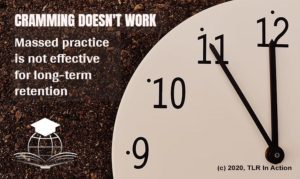
Author: Alice S. N. Kim
If you had to, how would you explain to someone else how you learn?
Take a moment to think about this, as you might find it interesting to see how your explanation relates to the information on learning below.
Learning styles
In my experience, the concept of “learning styles” almost always comes up in conversations about how people learn. Learning styles refers to the idea that individuals differ in terms of how well they learn depending on how the information is presented to them (for a review, see Coffield, Moseley, Hall, & Ecclestone, 2004). For example, if you’re a visual learner, you learn better when information is presented visually. Auditory learners excel when they hear or listen to the information, and kinesthetic learners do better when the information is presented kinesthetically. The idea that follows is that for any form of instruction to be most effective, information should be delivered to learners in a format that matches their learning preference (e.g. visual presentation of information for visual learners), which has important implications for education.
It’s important to note that although there is a large literature on learning styles, very few studies used the appropriate experimental methodology to assess its validity (for more information, see Pashler, McDaniel, Rohrer, & Bjork, 2009). Although research shows that people have preferences for how they would like information presented to them, the results of experimental studies do not support the idea that people actually learn better when they receive information through their preferred delivery mode (Pashler et al., 2009). What this means is that even though you may prefer receiving information visually, you won’t necessarily learn the material better if it is presented to you auditorily versus visually.
Cognitive learning principles
Regardless of how we prefer to have information presented to us, there are cognitive principles that generally apply to how we all process information. More specifically, scientists have been studying how we learn for over 100 years (e.g. Ebbinghaus, 1885/1913), and the results of this research, if applied, can benefit both our learning and teaching practices. Below are two of the most robust, evidence-based memory tips that everyone can start implementing in their daily lives.
Tip #1: Don’t cram, space out your studying.
I’ll bet that you’ve crammed before, but do you remember the information that you crammed?
We know that cramming can be effective for the very short term (e.g., memorizing a phone number just long enough to dial it, or a short list of groceries that you need to pick up from the store), but it isn’t effective for retaining information over the long run. A relevant finding in memory research is the spacing effect (Cepeda, Pashler, Vul, Wixted, & Rohrer, 2006). The spacing effect is a robust and highly reliable phenomenon, and it refers to the finding that we’re more likely to retain information better when we distribute (or space out) our study sessions compared to massing any repeated studying together. Spacing out your study sessions is essentially the opposite of cramming, where the same information is studied repeatedly within a very narrow or short time window. The benefit of distributed practice on memory has been shown in a variety of populations, including school-age children, young adults, middle age adults, as well as memory impaired patients (Carpenter, Pashler & Cepeda, 2009; Balota, Duchek, Sergent-Marshall, & Roediger, 2006).
Here is a concrete example of distributed practice: if you have 20 hours within the span of 2 weeks to learn the contents of a training manual, about 100 years of experimental research says that you are better off breaking up those 20 hours across the 2 weeks as opposed to cramming them all into 1 or 2 days. Conversely, as an educator, you could present key concepts and material repeatedly throughout your course and explicitly link them to other material you want your students to learn, as opposed to blocking off the material so that it is not covered again in class. In this way, even if your students are not spacing out their studying, they are being re-exposed and engaged with the material in a distributed manner through your classes.

(Image was produced for reuse, taken from https://tlraction.com/informational-placards/)
Tip #2: Practice retrieving the information from your memory, instead of re-reading/listening to it repeatedly.
Scientists have known for a long time that once you can retrieve the information in question from memory, this act of seeking and finding the information from your own memory will help you remember the information better compared to repeated exposures (e.g., reading, listening) to it (Butler & Roediger, 2007; Karpicke & Roediger, 2008).
Going back to the example above about learning the contents of a training manual, in those 20 hours that you have to learn the contents of a training manual, once you can recall the material from memory, you’re better off quizzing yourself (and in turn, engaging in retrieval practice) in lieu of more passive strategies, like re-reading the manual over and over. Just be sure to check that the answers you retrieve from memory are correct – it is okay to make mistakes as long as you catch them. As an educator, you can have your students engage in frequent and low-stakes retrieval practice in a variety of ways. For example, embedding discussion and/or reflection questions throughout your lectures is one way to have your students practice retrieval from memory, and an opportunity to revisit key concepts and ideas from previous lectures.

(Image was produced for reuse, taken from https://tlraction.com/informational-placards/)
References
- Balota, D. A., Duchek, J. M., Sergent-Marshall, S. D., & Roediger, H. L., III. (2006). Does expanded retrieval produce benefits over equal-interval spacing? Explorations of spacing effects in healthy aging and early stage Alzheimer’s disease. Psychology and Aging, 21, 19– 31.
- Butler, A. C., & Roediger, H. L. (2007). Testing improves long-term retention in a simulated classroom setting. European Journal of Cognitive Psychology, 19, 514-527.
- Carpenter, S. K., Pashler, H., & Cepeda, N. J. (2009). Using tests to enhance 8th grade students' retention of U. S. history facts. Applied Cognitive Psychology, 23, 760-771.
- Cepeda, N. J., Pashler, H., Vul, E., Wixted, J. T., & Rohrer, D. (2006). Distributed practice in verbal recall tasks: A review and quantitative synthesis. Psychological Bulletin, 132, 354–380.
- Coffield, F., Moseley, D., Hall, E., & Ecclestone, K. (2004). Learning styles and pedagogy in post-16 learning. A systematic and critical review. London: Learning and Skills Research Centre.
- Ebbinghaus, H. (1964). Memory: A contribution to experimental psychology. New York, NY: Dover. (Original work published 1885).
- Karpicke, J. D., & Roediger, H. L. (2008). The critical importance of retrieval for learning. Science, 319, 966-968.
- Pashler, H., McDaniel, M., Rohrer, D., & Bjork, R. (2008). Learning Styles: Concepts and Evidence. Psychological Science in the Public Interest, 9(3), 105–119.
- Sweller, J. (1988). Cognitive load during problem solving: Effects on learning. Cognitive Science, 12(2), 257-285.
*************************************************************************************************

This work is licensed under a Creative Commons Attribution 4.0 International License.

